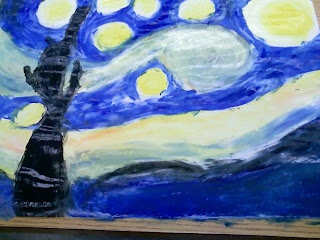
This activity could be used as a "thematic" scrapbook, for any topic in science, social studies, language arts, etc. Students can be as creative as they want with their assignments and keep them forever!



















Vincent van Gogh
Starry Night
Our goal was to recreate Van Gogh's famous Starry Night by fingerpainting. We were required to include his infamous texture and bright, bold colors by mixing the primary colors and black and white for shading and tinting. Then we wrote our own stories that went with our personal paintings. Teachers could use a "become the...." in any subject to give the students a new idea in learning!
A boy was in love with a girl and he wanted to give her something special. The girl was special and did not believe in material things. The boy promised her the moon, stars, and the night sky. She said she would marry him if he could deliver this. He wanted to marry her so badly but could not think of a way to give her something so unreachable. He went to his favorite thinking spot on the top of a hill, overlooking the town they lived in. He was about to give up when he looked up and noticed the scenery. He ran home as quickly as he could to get his paint and canvas. He stayed up all night painting all of the beautiful things he saw for her. The next morning when the girl awoke, she found him sitting next to her bed with a painting. She was so happy with his gift to her that she agreed to marry him immediately. They lived happily ever after.

For this composition, we were designed one element (shape) and one principle (contrast) of design. I choose stars as a shape. My main star in the center was created using yellow oil pastel with glitter. I surrounded the main star with smaller purple stars to really contrast the two colors. I then surrounded the smaller purple stars with the outline of pink, green, yellow, and turquoise in a way so their counter color would contrast them the best. I used a white and black background to really contrast the colors. The brightness of the colors appears to stick out the best of the black, yet as we can see the colors are brighter on the white side, thus effectively contrasting shape. This is a great art activity to get the students adjusted to the elements and principles as it incorporates group work, individual work, and creativity.



Frida Kahlo
Self-Portrait with Loose Hair
Description: The Facts:Analysis: The Design
Interpretation: The Meaning
Judgement: